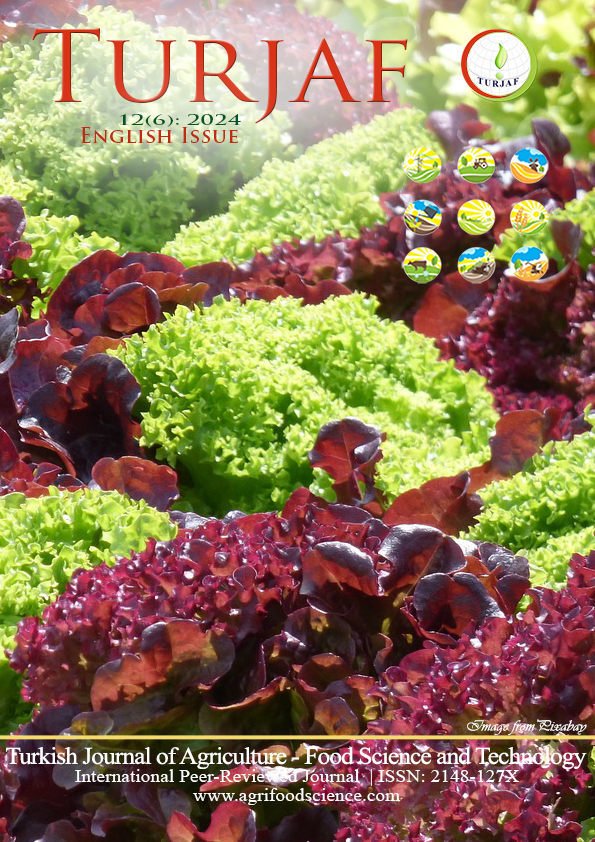The Effects of Different Thawing Procedures on Spermatological Parameters of Frozen Bull Sperm
DOI:
https://doi.org/10.24925/turjaf.v12i6.1068-1071.6803Keywords:
Bull, DNA damage, Sperm Quality, Thawing ProtocolAbstract
One of the most crucial elements influencing the efficacy of artificial insemination applications is semen quality. It is known that post-thaw semen quality was affected by thawing method. Errors made during the thawing process can compromise the motility, viability, morphology and DNA integrity of spermatozoa after thawing. This study was conducted to investigate the effects of four distinct thawing procedures on post-thaw semen quality in bulls. The first group was designated as 24°C (n=8); the straws in this group were thawed in a water bath at 24°C for 60 seconds. Second group was designated as 32°C (n=8); the straws in this group were thawed in a water bath at 32°C for 60 seconds. Third group was designated as 38°C (n=8); the straws in this group were thawed in a water bath at 38°C for 30 seconds. And the fourth group was designated as 70°C (n=8); the straws in this group were thawed in a water bath at 70°C for 7 seconds. Following the thawing process, motility, sperm morphology, viability, and DNA damage rate in spermatozoa were evaluated. Results showed that in 32°C group and 24°C group sperm motility significantly decreased when compared to 70°C and 38°C groups. Additionally, the 24°C group exhibited a significantly elevated DNA damage rate compared to the 70°C group, while no differences were observed in the other groups. In conclusion, the most ideal thawing procedures are at 70°C for 7 seconds and at 38°C for 30 seconds are recommended to get optimum sperm quality from frozen bull semen after thawing.
References
Aitken, R.J., Clarkson, J.S. & Fishel, S. (1989). Generation of reactive oxygen species, lipid peroxidation and human sperm function. Biol. Reprod. 41, 183-197.
Aksu, E. H., Akman, O., Ömür, A. D., Karakuş, E., Can, I., Kandemir, F. M., Dorman, E. & Uçar, Ö. (2016). 3, 3 diindolylmethane leads to apoptosis, decreases sperm quality, affects blood estradiol 17 β and testosterone, oestrogen (α and β) and androgen receptor levels in the reproductive system in male rats. Andrologia, 48(10), 1155-1165.
Barros, P.M.H., Nichi, M., Cortada, C.N.M., Carvalho, N.A.T., Baruselli, P.S., Barnabe R.C. & Barnabe V.H. (2007). Semen evaluation of Murrah buffalo bulls using sperm functional tests. Italian J. Anim. Sci. 6, 772-774.
Baskaran, S., Agarwal, A., Panner Selvam, M. K., Finelli, R., Robert, K. A., Iovine, C., Pushparaj, P.N., Samanta, L., Harlev, A. & Henkel, R. (2019). Tracking research trends and hotspots in sperm DNA fragmentation testing for the evaluation of male infertility: A scientometric analysis. Reproductive Biology and Endocrinology, 17(1)
Bearden, H.J., Fuquay, F., & Willard, S.T. Applied animal reproduction. 6th ed. Pearson Prentice Hallm: New Jersey; 2004.
Courtens, J.L., Ekwall, H., Paquignon, M. & Ploen, L. (1989). Preliminary study of water and some element contents in boar spermatozoa, before, during and after freezing. J. Reprod. Fertil. 87, 613-626.
Hatiboğlu, Y. (2014): Toluidin mavisi, anilin mavisi ve sperm kromatin dispersion testleri ile sperm dna hasar oranlarının kıyaslanması, Yüksek Lisans Tezi
Hayashi, Y., Isobe, N. (2005) Characteristics of cryopreserved spermatozoa from a Holstein-Friesian bull thawed at different temperature. J Inter Dev Coop 12(1): 107-110.
Kjoestad, H., Ropstad, E., & Andersen Berg, K. (1993). Evaluation of spermatological parameters used to predict the fertility of frozen bull semen. Acta Veterinaria Scandinavica, 34(3), 299-303.
Lyashenko, A. (2015). Effect of different thawing procedures on the quality and fertility of the bull spermatozoa. Asian Pacific Journal of Reproduction, 4(1), 17-21.
Marshall, C. (1984) Considerations for cryopreservation of semen. Zoo Biol 3(4): 343-356.
Nur, Z., Dogan, I., Soylu, M, & Ak, K. (2003) Effect of different thawing procedures on the quality of bull semen. Rev Med Vet 154(7): 487-490.
Ostashko, F.I. Cryopreservation and long-term storage of semen producers. 2nd ed. Ukraine: Harvest; 2001.
Rastegarnia, A., Shahverdi, A., Rezaei Topraggaleh, T., Ebrahimi, B., & Shafipour V. Effect of different thawing rates on post-Thaw viability, kinematic parameters and chromatin structure of buffalo (Bubalus bubalis) Spermatozoa. Cell Journal (Yakhteh) 2013; 14(4): 306-313.
Santi, D., Spaggiari, G., & Simoni, M. (2018). Sperm DNA fragmentation index as a promising predictive tool for male infertility diagnosis and treatment management - meta-analyses. Reproductive BioMedicine Online, 37(3), 315–326.
Selvam, M.K.P., Ambar R.F., Agarwal, A. & Henkel, R. (2021) Etiologies of sperm DNA damage and its impact on male infertility. Andrologia,53(1), e12706
Senger, P.L. (1980) Handling frozen bovine semen-factors which influence viability and fertility. Theriogenology, 13, 51-62.
Shoukir, Y., Chardonnens, D., Campana, A. & Sakkas, D. (1998). Blastocyst development from supernumery embryos after intracytoplasmic sperm injection: a paternal influence? Hum. Reprod. 13, 1632-1637.
Sönmez, M. (2015) Reprodüksiyon Suni Tohumlama ve Androloji Ders Notları, Elazığ
Zribi, N., Chakroun,N. F., Abdallah F. B., Elleuch, H., Sellami, A., Gargouri, J., Rebai, T., Fakhfakh, F. & Keskes, L.A. (2012) Effect of freezing–thawing process and quercetin on human sperm survival and DNA integrity, Cryobiology, 65, 3,326-331,
Downloads
Published
How to Cite
Issue
Section
License
This work is licensed under a Creative Commons Attribution-NonCommercial 4.0 International License.

























